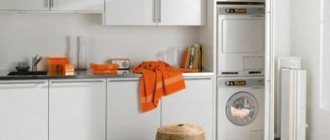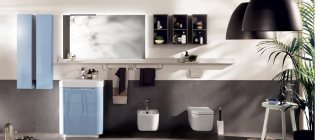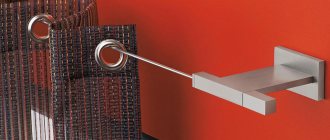Where to place the washing machine in the house?
We will describe the main pros and cons of placing a washing machine in the kitchen, which will help you weigh your own decision.
Main advantages:
- frees up space in a small bathroom;
- all engineering communications have been completed;
- we can install a large model, which often does not fit in the shower room;
- There is less air humidity in the kitchen, so there is no such risk of short circuit as in the bathroom.
If there is no space for a washing machine in the bathroom, the easiest way is to place it in the kitchen.
Flaws:
- if you choose the built-in option, repairing the equipment becomes more complicated;
- It is recommended to think about the storage of dirty things, gel, rinse aid, powder;
- takes up space that could be left under a cabinet for utensils;
- an open machine door can be in the way, as the machine needs to be ventilated.
Not every layout allows for space for this device in the bathroom.
If, after weighing everything, you still decide to install the machine in the kitchen, then check out the installation ideas.
Washing machine behind the door set
Often household appliances are hidden behind kitchen cabinet doors. This accommodation option is one of the most popular. There is no need to fit the washing machine into the interior of the room. Closed doors save kitchens in retro style: English, antique, Provence, country, Empire, vintage. In such a situation, a modern, innovative washing machine is simply not appropriate.
The cabinet can successfully accommodate a dryer and washing machine if there is enough space in the kitchen Source remontbp.com
A lot of free space is needed around a hidden machine. For the equipment to function properly, the doors on the headset must open and close well. There should be space left in the cabinet to accommodate the hoses. A washing machine for a small kitchen will have to be of reduced depth, with a small drum.
A washing machine covered with wooden doors fits perfectly into a loft-style kitchen Source remontbp.com
Leave a small gap on the left side when placing equipment behind the door. This will help avoid any hassles when pulling out the powder drawer. If possible, the optimal door opening angle is 90 degrees. Thus, nothing will interfere with full use of the drum. The cabinet for the machine can be located anywhere in the kitchen, even under the sink.
A washing machine can be easily hidden in a kitchen cabinet; the main thing is to choose the right size of the equipment or make a custom-made set Source krovati-i-divany.ru
Installing a washing machine: what should you immediately pay attention to?
There are many solutions for integrating a washing machine into furniture. In this case, it is necessary to comply with the general style of the kitchen set.
Interesting to know! There are simple and unusual installation methods. Of the latter, there is an option when the housing can be installed in a niche under the window.
To install the equipment correctly, several nuances are taken into account:
- Far from ovens, dishwashers and household appliances, as vibrations can disrupt the operation of the fans and compressors of these household appliances.
- Availability of free space for laundry (approximately 1 m2)
- Availability of space for free access to connecting the inlet and drain hoses.
When moving the machine to the kitchen, you need to be prepared to put up with some inconveniences.
Below are specific examples.
Disguise as a facade, with a door
The most popular idea for installing this household equipment. The appliances are covered with a countertop on top and a kitchen cabinet door on the front. If the design concept in the kitchen is developed in such a way that you do not want to disturb the design with an inappropriate type of household equipment, then this solution of installing a “washing machine” in the set is chosen.
With a competent approach to the matter, the washing machine will successfully fit into the kitchen interior.
In addition, a washing machine under the countertop in the kitchen does not affect the correct operation of kitchen appliances. However, remember that the washing machine creates vibration during operation.
Under countertop, without door
Sometimes a washing machine can look appropriate in a kitchen set without disguise. Household appliances in the same color ensemble are perceived well. Alternatively, you can fit the device under the countertop by covering it with a special film. In another case, you can order the service of decorating your car to match the color of the interior, decorating it in an artistic style.
Embedding the machine in a cabinet
In this case, the equipment can be built in not on the floor, but in a cabinet compartment. The equipment looks laconic in its built-in design. Below is usually a niche of a cabinet for utensils, above another section.
The main thing is to find the optimal place and install the machine correctly.
Thus, the standard built-in model of the machine fits succinctly into the kitchen design.
The advantage of this location! The housewife does not need to bend over or squat to load or unload laundry from the machine. In addition, this is a rational option for using space in the room.
Under the sink
When there is little space in the kitchen, the installation option under the sink is chosen. It may not be the best arrangement option, but in conditions of strict spatial economy it may be an ideal choice.
This is the most common way to install a washing machine.
In this case, the height of the machine should be no more than 70 cm, otherwise it will be difficult for children and small adults to reach it. You'll have to put up a stool.
- The depth of the washing machine should be 50 cm.
- The sink is also chosen correctly. A water lily with a height of up to 20 cm is suitable here. For safety reasons, the drain hose should not touch household appliances.
When installing, it is important to remember that different electrical appliances must be placed separated by at least one cabinet compartment.
On the one hand, it saves space, on the other hand, there are many disadvantages:
- limited dimensions of the machine;
- drainage into water lilies is subject to frequent blockages;
- installation requires a special siphon, which is difficult to find;
- there is a risk of water getting on the control board and other parts of the electronics, leading to damage to the machine.
Therefore, this installation is a controversial choice.
Installation in a cabinet cabinet
Hidden installation requires the use of a cabinet under the washing machine. Let's figure out how to hide it. The appliance does not fit into every kitchen interior. The device may not fit into the niche if at least 1 cm is missing. Therefore, it is recommended to think through all the installation nuances in advance. With this option, the SM is not located on the floor, but is built in above the bottom shelf of the cabinet. With this arrangement, the housewife does not need to bend or squat too much.
If a person is just choosing a machine for a finished kitchen, his tasks are much simplified, since manufacturers make many different products that differ in size. It is often possible to choose a device based on dimensions that will fit perfectly into the prepared niche.
Standard dimensions of a cabinet for a washing machine:
- Width - from 45 to 70 cm.
- Height - from 50 to 130 cm.
- Depth - from 33 to 85 cm.
Doors are used when it is necessary to hide equipment due to its unattractive appearance. To do this, you will have to assemble an additional bedside table, or attach the facade to the side of a nearby kitchen unit element.
Positioning the Top Loading Machine
Installing appliances in a small top-loading kitchen is inconvenient, but even here the design solutions are well thought out.
Remember that the washing machine vibrates during operation.
Two options are being considered:
- Manufacturers of the headset make a separate table for an individual washing machine. Thus, two issues are resolved, the equipment fits into the interior, while the table fully functions as an additional work area.
- The machine is built into a common wall, but the top of the tabletop or part of it is folded.
The first and second ideas solve the aesthetic and functional problem of placing equipment in a compact room. The rest depends on the personal preferences of the customer.
How to choose a built-in washing machine?
Before choosing a built-in washing machine, you need to pay attention to its dimensions, washing, spinning and energy consumption classes and available additional functions.
Dimensions
In the case of built-in appliances, dimensions are of utmost importance. You always buy a built-in washing machine first, and only then organize a place for it. The dimensions for embedding are indicated in the instructions; you cannot rely on the dimensions written in reviews on websites or, especially, on the price tag, since they are usually rounded. Thus, 57.4 cm can turn into 57, but in practice it turns out that by these 4 mm the machine will be wider than the opening.
Among the built-in models there are no narrow ones, and this is understandable. The standard depth of the set is 60 cm, respectively, in order to make the most efficient use of the free space, the built-in automatic washing machine must fill it almost completely (you just need to leave room for the hoses). Therefore, the depth of such models ranges from 53 to 60 cm.
The principle of maximum filling of free space is also used when designing the height and width of built-in washing machines. Therefore, their height ranges from 82 to 84 cm (standard headsets are 85 cm in height), and their width is from 58 to 60 cm.
Loading
Loading in the case of built-in units rarely affects the choice of model, unlike free-standing equipment. The thing is that built-in washing machines are quite spacious; they contain from 5 to 8 kg of dry laundry, which can satisfy most consumers.
Washing, energy consumption and spin class
There are no special nuances here - the higher the class, the more economical the built-in washing machine will work, the better it will wash and spin. But it may also cost more. At the moment, in terms of washing class, all commercially available models belong to class A, and you can also easily find models with spin class A and energy consumption class A+++.
Additional functions
The more there are, the better. Built-in washing machines are usually multifunctional, so pre-wash, quick wash, and delay start are available in all models. Separately, you should pay attention to protection against leaks. The fact is that with free-standing equipment, a broken hose or a hole in the tank is much easier to detect. The built-in washing machine is hidden in the unit, water can accumulate under it out of sight and you can only find out about the leak a few days later, when neighbors from below come with complaints.
Features of location in a small kitchen
Another nuance that raises doubts is noise and vibration in the kitchen. Today's technologies make it possible, if not to solve the problem as a whole, to reduce noise to a minimum.
In a small kitchen you can find space for a washing machine.
Solution! Install the equipment on ceramic or porcelain tiles, which, compared to linoleum or parquet, reduce noise and vibration levels. Also, the location behind the door and the correct adjustment of the legs almost completely eliminates noise. In some cases, soundproofing materials are used.
Most often there is no place for powders in the kitchen.
In addition to the correct integration of household equipment into the set, it is necessary to provide storage space for gels, rinse conditioners, powders, and tablets. This compartment is necessary so as not to constantly run to the bathroom for washing detergents.
It is better if the washing machine is on the floor.
Washing machine under the countertop
Even the smallest kitchen has space for a countertop. You need to use the space underneath it rationally. To do this, you need to replace the usual kitchen cabinet for storing things with household appliances. Pots and plates fit well on hanging shelves. A washing machine in the kitchen under the countertop is the fastest and easiest way to install. This solution saves space and does not require large expenses. In a small apartment, the countertop is often combined with a window sill.
The location of the washing machine under the countertop saves space and looks harmonious against the background of white tiles in the work area Source archidea.com.ua
The machine always remains in sight; the absence of a door provides free access when loading things before washing and constant monitoring of the process. If the design of the equipment does not fit well into the overall scheme of the room, it is advisable to decorate the front part with decorative stickers or artistic painting.
A white washing machine and a white stove look great in an interior with a wood-effect kitchen unit Source archidea.com.ua
When choosing a model, special attention should be paid to colors. It is ideal if the shade is similar to the color scheme of the kitchen set or countertop. If the store only offers traditional white cars, don’t be upset. This color is universal and will fit into almost any style and design.
Placing the washing machine and dryer next to the sink will ensure easy and simple installation of equipment Source remontbp.com
How to install a washing machine yourself?
Devices are installed by specialists or apartment owners themselves. The second method requires the presence of certain skills.
Leave gaps between its surface and the cabinet walls.
How to install a washing machine under a countertop?
- The machine is placed between two compartments of the headset and covered with a tabletop.
- The device is placed in a separate compartment.
- If the machine is equipped with places for fastening furniture hinges, then it is placed between the compartments of the set, and doors are installed on top.
In any case, the bottom of the washer is covered with a panel.
This option is suitable for rooms with a minimalist design, for example, in a high-tech style.
We follow the installation rules:
- There is no back wall to prevent overheating and ensure circulation.
- It is better when the device stands on the floor or is installed on a stable cabinet. We do not recommend installing it on the cabinet base.
- Installing kitchen utensils on the appliance is not recommended. The dishes will break and the external body of the equipment may be damaged.
- The device is installed on a perfectly flat surface. If this is not possible, then adjustable legs should be used. We measure the location with a level.
- Do not install the machine close to the countertop to avoid difficulties in accessing the gel filling compartment.
Prepare your tools:
- level;
- roulette;
- set of wrenches;
- fluoroplastic sealing tape;
- shut-off valve;
- screwdriver;
- hoses;
- pliers.
Before work you need to prepare all the necessary tools.
Serial connection of the machine:
- We close the shut-off valve in the water supply system.
- The drain hose is connected to the sewer through a rubber siphon, which prevents the spread of odors.
Important! Use only the hose that comes with the machine, as it is adapted to the specific pump modification. Otherwise, the extension leads to malfunctions of the pump, sometimes even to breakdown.
- A flexible hose is connected to the water supply. In this case, a valve must be installed on it. In the event of repairs or an emergency, you do not deprive the entire home of water supply. Don't forget to install an inlet and drain filter.
- The connection to the network must be from the current distributor panel, using a grounding current.
- Since the machine is sometimes installed in a room with high humidity, it is recommended to connect it to a waterproof outlet.
All of the above recommendations will not only help save space, but also make it more functional and aesthetically harmonious.
Main stages of work
After approval of the project and installation of the kitchen unit, the installation of the device is carried out directly. Fully built-in appliances, as a rule, during the installation process provide for the presence of a furniture plinth at the bottom of the machine. For this purpose, there is a special recess on the body. The height is adjusted with special legs. The front door is attached to the machine body with special hinges. Connecting to communications is carried out in the same way as connecting classic devices.
You may be interested in: Hood design in a modern kitchen
The integration of a free-standing machine into a set begins with removing the top cover. Sometimes the top of the case is covered with a special plate, which is included in the kit. Next, all overall dimensions of the niche are checked and made sure that they correspond exactly to the dimensions of the built-in machine.
Washing machine hose connection diagram.
After this, the water supply and sewer drain are connected. When calculating water communications, it is advisable to take into account the length of the supply hoses, that is, there must be a certain reserve that will allow, if necessary, to pull the washing machine out of the unit without disconnecting the pipelines.
The pressure hose is connected to the water main using a tee, which is installed in a convenient place where there are threaded connections, for example, at the point where the mixer hose joins the cold water pipeline. A shut-off valve is installed between the outlet of the tee and the pressure hose of the machine. It is possible to install a tee directly into the main by welding it into a plastic water supply or using a fitting connection.
The drain hose can be connected in two ways. In the first case, a special drain siphon is required in the kitchen sink, which has an outlet for connecting a hose. In the second case, a tee is inserted into the sewer bed running in the kitchen, and a drain pipeline is connected to it. It is important to remember here that before entering the sewer, the drain hose must have an elbow-shaped bend 45-50 cm high.
Layout of sockets when connecting a washing machine.
The electrical part includes the presence of a power outlet or residual current device in the apartment circuit. If this is not available, then it is possible to install a special socket in which an RCD is built in. It is important to remember about grounding; if it is not provided for in the house design, then the presence of an RCD is mandatory, and grounding of an earthen allotment is strictly prohibited.
After connecting the communications, the washing machine is pre-installed in the niche of the unit; during the installation process, the location of the hoses is monitored, while avoiding their kinks. Then a test run of the device is carried out and an inspection is carried out for leaks. After this, the machine is finally installed, maintaining the level. At the final stage, facade doors are hung, if they are provided for in the project.
You may be interested in: How to make chandeliers and lamps for the kitchen?
Sometimes the order of work may change, this is due to some points and features of assembling the headset. For example, connection to pipelines can occur after installing the device in the suite, through adjacent cabinets. This is not a very good installation option.
Options for installing a washing machine in the kitchen in the photo
The cost of installing and connecting a washing machine
The cost of connecting a washing machine varies depending on the installation location, the need for its preparation, as well as the use of additional components. The standard price for work performed by our specialists is shown in the table below. In addition, you can find out how much it costs to connect a washing machine by calling the numbers provided.
| List of works | Materials (included in price) |
| Connection to ready-made communications, price 1,000 rubles. | |
|
|
| Connecting a washing machine to electricity, price 2,000 rubles. | |
|
|
| Connection to water supply and sewerage, price 2,000 rubles. | |
|
|
| Full connection of the washing machine, price 3,000 rubles. | |
|
|










